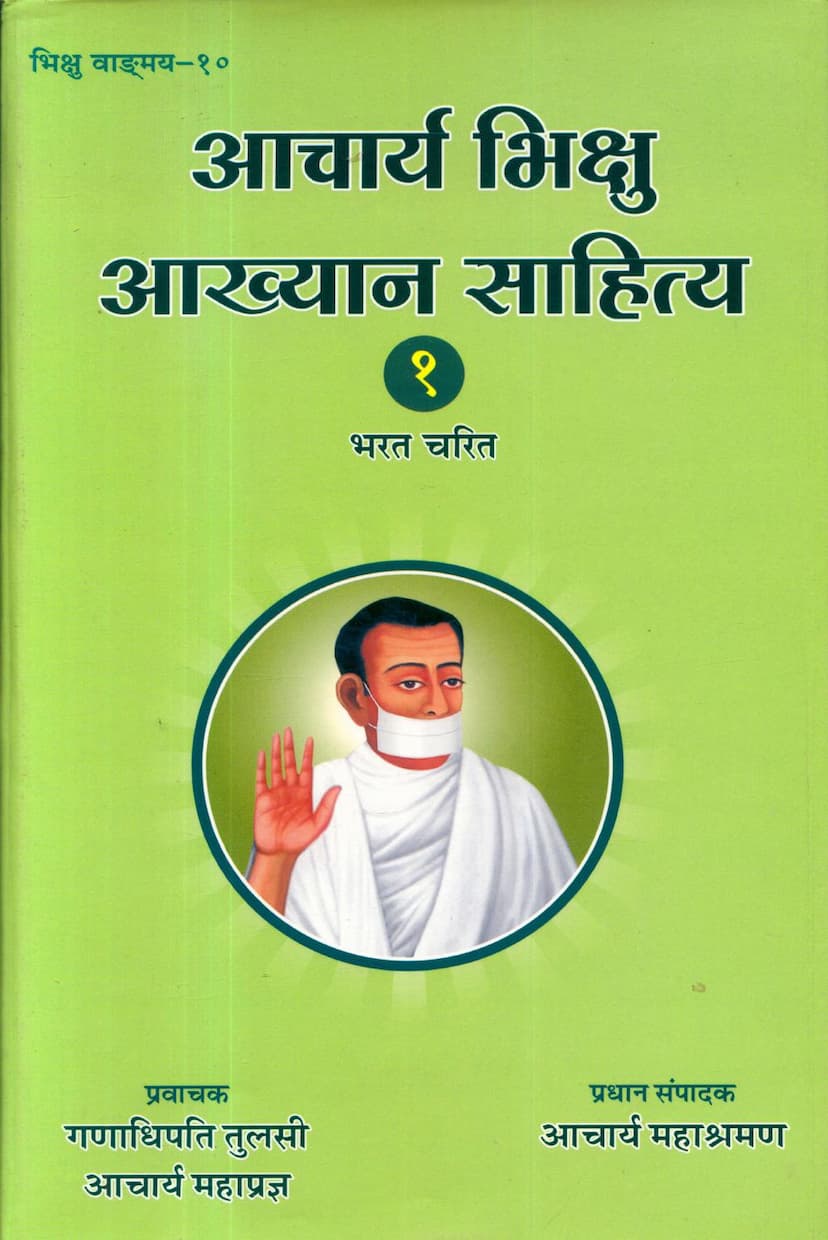Acharya Bhikshu Aakhyan Sahitya 01
Added to library: September 1, 2025

Summary
This Jain text, "Acharya Bhikshu Aakhyan Sahitya 01," published by Jain Vishva Bharati and authored by prominent figures like Tulsi Ganadhipati, Acharya Mahapragya, Acharya Mahashraman, Muni Sukhlal, and Muni Kirtikumar, is a comprehensive collection of Aakhyan (narrative) literature by Acharya Bhikshu. The book focuses on the "Bharat Charitra" (The Story of Bharat) as the primary narrative.
Here's a summary of its key aspects, derived from the provided pages:
1. Acharya Bhikshu as a Literary Figure:
- The text highlights Acharya Bhikshu's intellectual prowess, describing him as a sharp debater and a visionary for compiling his dialogues.
- His significant contribution lies in composing philosophical knowledge in verse, specifically in the style of folk songs. This makes his work accessible and memorable, even for the illiterate, as songs are easy to remember and perpetuate.
- Acharya Bhikshu's poetry is described as eloquent and imbued with rasa (aesthetic sentiment). Beyond philosophical works, he also showcased his literary skill through akhyan literature, which vividly portrays the contemporaneous folk culture and delves into the depths of the human mind. The authors suggest a whole book is needed to discuss his poetic contributions in detail.
2. The Significance of "Bhikshu Vangmaya":
- The "Bhikshu Vangmaya" is considered as important as Agamas (sacred Jain texts) for the Terapanth tradition. Acharya Bhikshu is seen as instrumental in clarifying the original thought-stream of Lord Mahavir, which had become obscured over time.
- Acharya Tulsi and Acharya Mahapragya are credited with bringing Acharya Bhikshu's work to the world. Although Acharya Jayacharya also followed Acharya Bhikshu's teachings, his writings were primarily in Rajasthani and lacked wide dissemination. Tulsi and Mahapragya revitalized interest in Acharya Bhikshu, sparking a new sense of reverence for his experiential treasury of wisdom.
3. The Rajasthani Language and Acharya Bhikshu's Work:
- The text acknowledges that Rajasthani is becoming less accessible, but the vast literature produced in it by Jain acharyas demonstrates its expressive capability. Acharya Bhikshu's extensive writings in Rajasthani are highlighted as a significant contribution that serves as a strong foundation for the language's recognition.
- The compilation aims to preserve the originality of Acharya Bhikshu's work, including the variations in spelling of words like "ashrav" (which appears as aasrav, aasvar, aasav, aashv). The use of dots with letters, prevalent in contemporary Rajasthani, has also been maintained to preserve the historical linguistic context.
4. Classification of Bhikshu Vangmaya:
- Acharya Bhikshu's vast literary output is categorized into four parts:
- Tattvadarshan (Philosophical Insight)
- Achar Darshan (Ethical Philosophy)
- Upadeshik (Didactic/Admonitory)
- Akhyan Sahitya (Narrative Literature)
5. Focus on "Bharat Charitra":
- The book specifically discusses "Bharat Charitra" as a significant work within Acharya Bhikshu's narrative literature.
- It is noted as his largest akhyan, drawing its basis from Jambudvip Prajnapti but incorporating other sources and Acharya Bhikshu's own intellect to connect the narrative.
- The akhyan details Bharat's immense wealth as a Chakravarti (universal monarch), earned through both inheritance and his own might. Bharat's sixty thousand years of life are largely spent in warfare, with detailed accounts of his journeys and battles.
- The narrative vividly describes Bharat's pursuit of sovereignty, even challenging his brother Bahubali. The battles, including passing through the Tamas cave and fighting with the Tamas Chilaati tribes, are described as thrilling. The victory journey beyond the Ganga and Indus rivers is also considered wondrous.
- The text enumerates Bharat's immense possessions: fourteen jewels, nine treasures, sixteen thousand celestial attendants, sixty-four thousand subordinate kings, vast armies, and numerous cities, towns, and mines.
- The description extends to his palaces, his extensive harem of sixty-four thousand queens (including Sri Devi), their beauty, and the opulent lifestyle, such as a maid grinding diamonds to make a tilak.
- The core message of the Bharat Charitra is Bharat's detachment from this immense wealth, even when revealed by Lord Adinath himself. Bharat's skill in resolving doubts about his detachment is highlighted. The akhyan, composed in 74 dhalas (stanzas/chapters), vividly portrays Bharat's detached attitude in various contexts.
- The narrative emphasizes the impermanence of worldly pleasures through Bharat's life, stating that those who desire merit desire sensory pleasures, and considering the world as substantial is a great delusion.
- The book highlights the vivid description of Bharat's attainment of Keval Gyan (omniscience) in the Adarsh Bhavan, his renunciation of adornments, the ensuing lament in the royal chambers, and his indifference to it. The impact of his teachings to kings about the transience of material happiness and the bliss of liberation is also noted as a powerful display of detachment.
- The authors underscore Acharya Bhikshu's literary genius in capturing the essence of bhoga (enjoyment) versus tyaga (renunciation) and the profound portrayal of vairagya rasa (sense of detachment).
3. Translation and Publication:
- The Hindi translation of the Bhikshu Vangmaya was undertaken by Professor Muni Sukhlalji on the instruction of Acharya Mahapragya, during the 200th anniversary of Acharya Bhikshu's nirvana. Muni Kirtikumarji and Muni Bhavyakumarji also contributed to the proofreading.
- Jain Vishva Bharati is the publisher, and the publication is dedicated to the memory of the late Prithvirajji and Vijaychandji Chhajed.
In essence, "Acharya Bhikshu Aakhyan Sahitya 01: Bharat Charitra" is a significant Jain literary work that not only presents a detailed narrative of Lord Bharat's life, emphasizing his detachment amidst immense wealth and power but also showcases Acharya Bhikshu's exceptional poetic talent and contribution to Jain literature in the Rajasthani language. The book is a testament to Jain teachings on renunciation, detachment, and the ultimate pursuit of liberation.